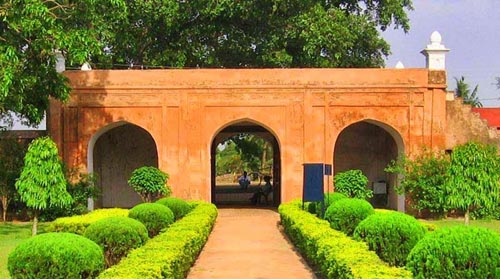Alivardi Khan Tomb

Information on Alivardi Khan Tomb (Murshidabad, West Bengal) - History & Architecture
Tomb of Alivardi Khan is a popular cemetery situated in reverse bank of Bhagirathi river of Murshidabad in West Bengal. It is also known as Khushbagh or Garden of Happyness. It buries Alivardi Khan, the nawab of Bengal. Apart from Alivardi Khan, this place is also reputed as the burial place of his mother, his grandson, Nawab Siraj-ud-Dulah and his grandson's wife Luff-un-nisa. Basically, Tomb of Alivardi Khan hosts the graves of the rulers of Bengal who belong to the Afsar family.
Alivardi Khan Tomb Architecture
Tomb of Alivardi Khan was created on 7.65 acres of area and surrounded by continued wall. There lies a wonderful garden which comprise three walled enclosures. At the center of the garden, there is a grave which contain the tomb of Alivardi Khan along with other members of the family. The tomb include a block encompassing little features of oriental architectural style. The entire structure has significant resemblance with excellent British architectural style. It consisted strapped enclosures with strange walls which were curve holed for musketry.
Tomb of Alivardi Khan includes a four-sided and flat ceiled building, upraised two feet from the ground and loomed by small steps. The building is bounded by arcaded terrace with five curved openings, leaving an inner square compartment at the core, where the tomb of Alivardi Khan is situated. The interior of the tomb is quite similar to the design of Bibi Pari's tomb in Dhaka. On the other hand, the exterior of the tomb is rounded with open arches and do not fit with Muslim architectural style. The tomb also hosts a mosque, created by Alivardi Khan according to the design of Jama Masjid of Delhi.
Alivardi Khan Tomb History
The Tomb of Alivardi Khan was created by the first Nawab of Bengal, i.e. Alivardi Khan himself. He was an essential ruler of Bengal who died in the year 1756. After his demise, his younger grandson Siraj-ud-Dulah was bestowed with the power of Bengal. However, his concluding position was uncertain due to displeasure among his colonels. He died in the year 1757 during the 'Battle of Plassey'. After the demise of Siraj-ud-Dulah, his wife flown to Dhaka. However, she returned to Murshidabad after few years. History says that she lived in Murshidabad for rest of the life and was tended the grave in the year 1786 AD with about 108 ranges of roses, which were grown in the garden, Alivardi Khan developed. It is also believed that she spend considerable amount of money for the maintenance of the garden and after her death she was buried nearby the tomb of his companion, Siraj-ud-Dulah. Its historical importance is quite impeccable as it was the ruler himself who had constructed and both of them were buried near to each other. Thus from historical point of view, it is considered quite important as here many great rulers and personalities were buried that reminds us of those era.
Alivardi Khan Tomb Tourism Importance
Characterised by significant architectural style and historical importance, Tomb of Alivardi Khan can be regarded as great tourism place. By visiting this place, travellers can not only enjoy the stunning view of the tombs, but also understand the historical facts related with it. Tomb of Alivardi Khan contributes to the social and constitutional activities which takes place in ancient times. The large gardens, graves, mosque and buildings that existed in the palace are regarded as a feast to the eyes for the travellers.
- Andaman Nicobar Monuments
- Andhra Pradesh Monuments
- Assam Monuments
- Bihar Monuments
- Chhattisgarh Monuments
- New Delhi Monuments
- Goa Monuments
- Gujarat Monuments
- Haryana Monuments
- Himachal Pradesh Monuments
- Jammu and Kashmir Monuments
- Karnataka Monuments
- Kerala Monuments
- Madhya Pradesh Monuments
- Maharashtra Monuments
- Odisha Monuments
- Punjab Monuments
- Rajasthan Monuments
- Tamil Nadu Monuments
- Telangana Monuments
- Uttar Pradesh Monuments
- West Bengal Monuments